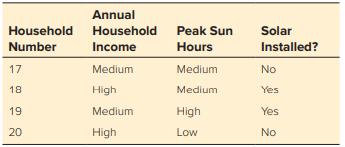As discussed throughout Chapter 3, the owner of Evergreen Solar (Jennifer) has been exploring different ways of
Question:
As discussed throughout Chapter 3, the owner of Evergreen Solar (Jennifer) has been exploring different ways of performing predictive analytics in order to better predict whether any new sales lead is sufficiently likely to go ahead with having solar installed to justify her spending the time and money involved to pursue this sales lead. With just 16 historical records, she has found that there are several ways of making a helpful prediction, but that the prediction does not have much precision because the historical data are so limited. In fact, she has found that either predictor variable (the annual household income or the rooftop’s peak sun hours) often can be changed rather substantially without changing the prediction. Therefore, it seems sufficient to only specify that each predictor variable falls within a fairly broad range in order to make the prediction.
Jennifer now has been given a demonstration of how the naïve Bayes algorithm (see Section 3.4) could be used to provide her predictions. She is excited that this algorithm only uses categorical variables, so the values of the predictor variables only need to be specified as being within a fairly broad range. Section 3.4 identifies these ranges and labels them as low, medium, and high. (See Table 3.3 for the labels assigned to the 16 historical records.) Jennifer understands that a new sales lead is unlikely to have solar installed if either predictor variable is in the low category but that this likelihood increases rather rapidly as the predictor variable increases substantially. Therefore, she has concluded that she can immediately decide not to pursue a new sales lead if either predictor variable is in the low category but that she should pursue a new sales lead if either predictor variable is in the high category and the other one is not in the low category. She loves the idea that she can make the decision so easily and so immediately.
However, what if both predictor variables are in the medium category? This case is not clear yet. The demonstration of the naïve Bayes algorithm that Jennifer received actually did involve a new sales lead that fits this case. But the resulting prediction for this sales lead was somewhat ambiguous (a prediction that this sales lead was not likely to have solar installed but that the estimated probability that it actually would have solar installed was quite high at 0.471.) Jennifer would like to obtain more information to help her decide what to do about such cases.
Fortunately, some time now has passed, so Jennifer recently has gone ahead with four more new sales leads, so she now has 20 historical records instead of 16 with which to apply the naïve Bayes algorithm again. The data for these four additional historical records are shown below.

In addition, Jennifer now has a brand new sales lead (labeled below as the predictor record) that has both medium household income and medium peak sun hours.
a. Use the complete Bayes algorithm (direct method) to predict whether this predictor record is likely to have solar installed and to estimate the probability that this will happen.
b. Use the version of the complete Bayes algorithm that uses Bayes theorem to obtain the results requested in part a.
c. Now use the naïve Bayes algorithm to obtain the results requested in part a.
d. The results from this application of the naïve Bayes algorithm with 20 historical records did not change much from when 16 historical records were used in Section 3.4. Jennifer can see some significant differences in the predictor values in the medium categories for the various historical records and she would like to differentiate better between the predictor records hat fall into these categories. What would you recommend that she do in the future to better predict which of these predictor records she should pursue in the future?
e. Use Analytic Solver to apply the naïve Bayes algorithm to perform part c.
Step by Step Answer:

Introduction To Management Science and Business Analytics A Modeling And Case Studies Approach With Spreadsheets
ISBN: 9781260716290
7th Edition
Authors: Frederick S. Hillier, Mark S. Hillier





